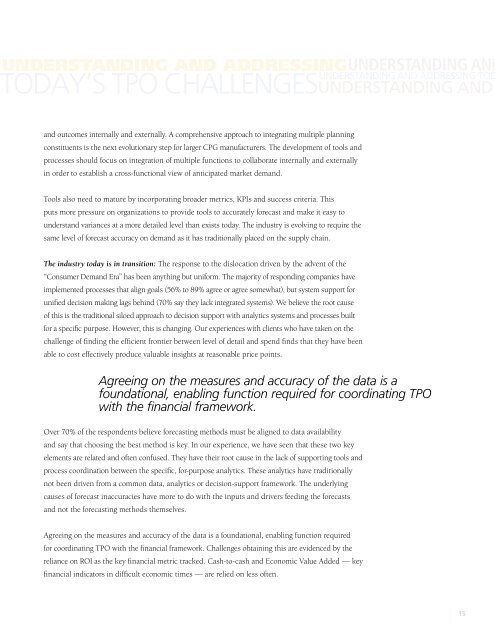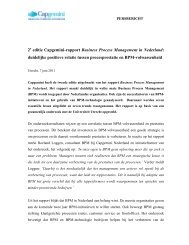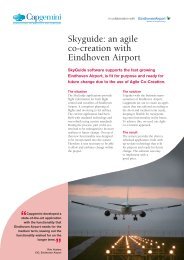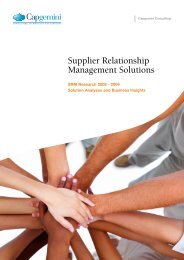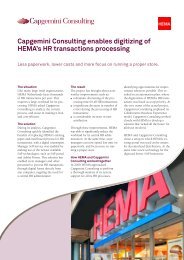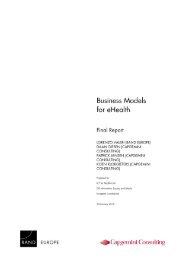ROI - Capgemini
ROI - Capgemini
ROI - Capgemini
You also want an ePaper? Increase the reach of your titles
YUMPU automatically turns print PDFs into web optimized ePapers that Google loves.
understanding and addressingUnderstanding and<br />
Understanding and Addressing Tod<br />
Understanding and<br />
today’s tpo challenges<br />
and outcomes internally and externally. A comprehensive approach to integrating multiple planning<br />
constituents is the next evolutionary step for larger CPG manufacturers. The development of tools and<br />
processes should focus on integration of multiple functions to collaborate internally and externally<br />
in order to establish a cross-functional view of anticipated market demand.<br />
Tools also need to mature by incorporating broader metrics, KPIs and success criteria. This<br />
puts more pressure on organizations to provide tools to accurately forecast and make it easy to<br />
understand variances at a more detailed level than exists today. The industry is evolving to require the<br />
same level of forecast accuracy on demand as it has traditionally placed on the supply chain.<br />
The industry today is in transition: The response to the dislocation driven by the advent of the<br />
“Consumer Demand Era” has been anything but uniform. The majority of responding companies have<br />
implemented processes that align goals (56% to 89% agree or agree somewhat), but system support for<br />
unified decision making lags behind (70% say they lack integrated systems). We believe the root cause<br />
of this is the traditional siloed approach to decision support with analytics systems and processes built<br />
for a specific purpose. However, this is changing. Our experiences with clients who have taken on the<br />
challenge of finding the efficient frontier between level of detail and spend finds that they have been<br />
able to cost effectively produce valuable insights at reasonable price points.<br />
Agreeing on the measures and accuracy of the data is a<br />
foundational, enabling function required for coordinating TPO<br />
with the financial framework.<br />
Over 70% of the respondents believe forecasting methods must be aligned to data availability<br />
and say that choosing the best method is key. In our experience, we have seen that these two key<br />
elements are related and often confused. They have their root cause in the lack of supporting tools and<br />
process coordination between the specific, for-purpose analytics. These analytics have traditionally<br />
not been driven from a common data, analytics or decision-support framework. The underlying<br />
causes of forecast inaccuracies have more to do with the inputs and drivers feeding the forecasts<br />
and not the forecasting methods themselves.<br />
Agreeing on the measures and accuracy of the data is a foundational, enabling function required<br />
for coordinating TPO with the financial framework. Challenges obtaining this are evidenced by the<br />
reliance on <strong>ROI</strong> as the key financial metric tracked. Cash-to-cash and Economic Value Added — key<br />
financial indicators in difficult economic times — are relied on less often.<br />
15


